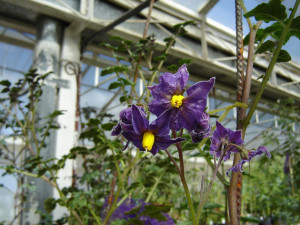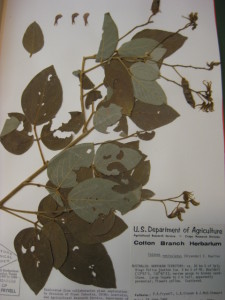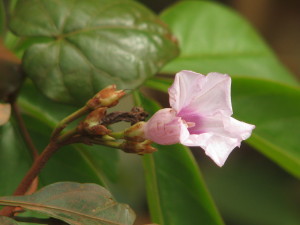Category : News
Published : April 30, 2015 - 10:09 AM
Recently, CIATs Crop Wild Relative (CWR) team published three papers on conservation needs and genetic resources potential for the wild relatives of pigeonpea, potato and sweetpotato. These efforts were performed as part of a 10-year global initiative to collect and safeguard the CWR of the worlds major crops in order to provide plant breeders with the genetic diversity projected to be needed for climate change adaptation (www.cwrdiversity.org).
Pigeonpea
The paper on pigeonpea, featured in Biological Conservation, explored the distributions and ex situ conservation status of the 15 CWR species of pigeonpea, and then investigated their potentialas genetic resources for abiotic stress tolerance. Pigeonpea, a versatile, stress-tolerant, and nutritious grain legume, offers great potential for increasing agricultural sustainability and improving human nutrition in sub-tropical and tropical regions. Current breeding objectives for pigeonpea include increasing its tolerance to abiotic stresses, including heat, cold, drought, and waterlogging.
The paper assessed the potential for pigeonpea CWR to be further employed in crop improvement by compiling wild species occurrence and ex situ conservation information, producing geographic distribution models for the species, applying gap analysis to identify gaps in the comprehensiveness of current germplasm collections, and using eco-geographic information to identify CWR populations with the potential to contribute agronomic traits of priority to breeders. It was found that the pigeonpea CWR are broadly underrepresented in ex situ conservation systems, with 80% of the species assessed as high priority for further collecting. Finally, species and geographic locations for further collecting of pigeonpea CWR germplasm were identified.
Potato

Solanum incamayoense: A potato wild relative growing in a greenhouse of the INTA Balcarce research station for regeneration. Photo by A. Digilio.
The paper on potato, published in PLOS ONE, explored the ex situ conservation status of the CWR of this most important staple crop. CWR have a long history of use in potato breeding, particularly for pest and disease resistance, and are expected to be increasingly used in the search for tolerance to biotic and abiotic stresses. In the context of habitat destruction and climate change,actions to ensure potato CWR conservation ex situ become ever more urgent. The aim of the research was to establish priorities for further collecting to fill important gaps in germplasm collections. The state of ex situ conservation of 73 of the closest wild relatives of potato was analyzed by applying environmental niche modelling and gap analysis. Almost half of the species were assigned high priority for further collecting. Such collecting efforts combined with further emphasis on improving ex situ conservation technologies and methods, performing genotypic and phenotypic characterization of wild relative diversity, monitoring wild populations in situ, and making conserved wild relatives and their associated data accessible to the global research community, represent key steps in ensuring the long-term availability of the wild genetic resources of this important crop.
Sweetpotato
In Frontiers in Plant Science, CIATs CWR team published a paper on sweetpotato. Sweetpotato is a root crop of critical importance to food security in tropical and subtropical regions, particularly of Southeast and East Asia, and Sub-Saharan Africa. Given its significance in these areas, it is surprising that the crop wild relatives (CWR) of sweetpotato are underutilized in crop improvementin comparison to wild species utilization in crops with similar dietary roles and with equivalent pest, disease, and abiotic stress challenges, such as potato and cassava.
This underutilization stems from uncertainty in regard to species boundaries and their phylogenetic relationships, limited availability of germplasm with which to perform crosses, and the difficulty of introgression of genes from wild species. To help to address these research challenges, the team revised the taxonomic and geographic information on sweetpotato CWR species, modeled their distributions, determined their conservation status, and explored their adaptations to climatic and edaphic characteristics. Recommendations were then made for further conservation actions with the dual goals of making these resources available to breeders, and providing the basic materials needed by researchers to understand the diversity present in the CWR of sweetpotato. It was found that the sweetpotato species are urgently in need of further collecting to be adequately conserved.
Comparison on CWR issues and needs
A gap analysis methodology was used in all three articles. In the case of potato, it was applied to a widely studied, major crop to reveal the current state of conservation and availability of CWR in gene banks. For pigeonpea and sweetpotato, less well researched crops with great potential in developing regions, both conservation status and potential uses for abiotic stress tolerance were investigated. The analyses revealed that the CWR of potato, pigeonpea and sweetpotato are in need of substantial further efforts to ensure their conservation and availability for crop improvement.
References
- Castañeda-Álvarez NP, de Haan S, Juarez H, Khoury CK, Achicanoy H, Sosa CC, Bernau V, Salas A, Heider B, Simon R, Maxted N, and Spooner DM (2015). Ex situ conservation priorities for the wild relatives of potato (Solanum L. sectionPetota). PLoS One. doi: 10.1371/journal.pone.0122599. Available online at: http://dx.plos.org/10.1371/journal.pone.0122599
- Khoury CK, Castañeda-Álvarez NP, Achicanoy H, Sosa CC, Bernau V, Kassa MT, Norton SL, van der Maesen LJG, Upadhyaya HD, Ramírez-Villegas J, Jarvis A, and Struik PC (2015). Crop wild relatives of pigeonpea [Cajanus cajan (L.) Millsp.]: Distributions, ex situ conservation status, and potential genetic resources for abiotic stress tolerance.Biological Conservation 184: 259-270. doi: 10.1016/j.biocon.2015.01.032. Available online at: http://www.sciencedirect.com/science/article/pii/S0006320715000531
- Khoury CK, Heider B, Castañeda-Álvarez NP, Achicanoy H, Sosa CC, Miller RE, Scotland RW, Wood JRI, Rossel G, Eserman LA, Jarret RL, Yencho GC, Bernau V, Juarez H, Sotelo S, De Haan S, and Struik PC (2015). Distributions, ex situ conservation priorities, and genetic resource potential of crop wild relatives of sweetpotato [Ipomoea batatas (L.) Lam., I. series Batatas]. Frontiers in Plant Science 6, 251. doi:10.3389/fpls.2015.00251. Available online at: http://journal.frontiersin.org/article/10.3389/fpls.2015.00251/abstract
Written by : Nora Castañeda-Álvarez and Colin Khoury. Nora Castañeda-Álvarez (PhD student in Biosciences) and Colin Khoury (PhD student in Plant Sciences) are part of the Crop Wild Relatives team of CIAT, the International Center for Tropical Agriculture.


